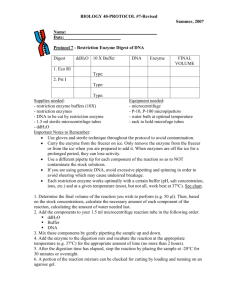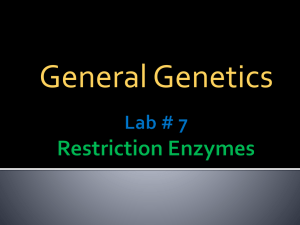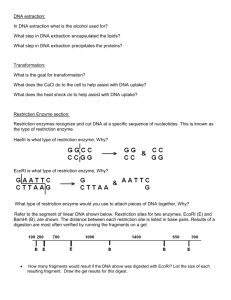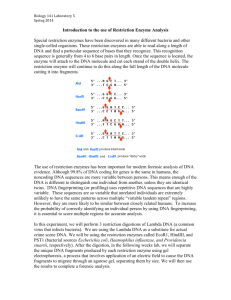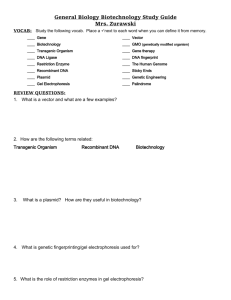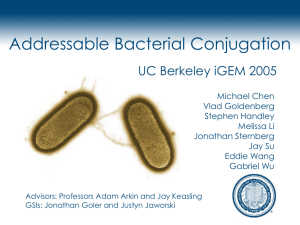Introduction - OpenWetWare
advertisement
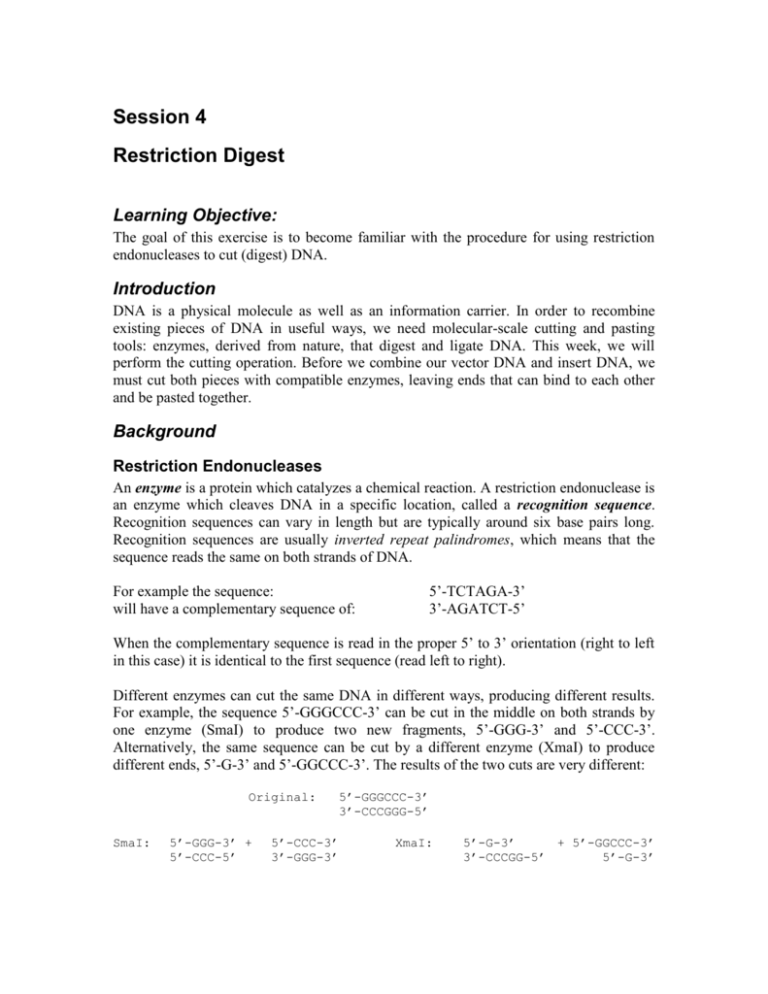
Session 4 Restriction Digest Learning Objective: The goal of this exercise is to become familiar with the procedure for using restriction endonucleases to cut (digest) DNA. Introduction DNA is a physical molecule as well as an information carrier. In order to recombine existing pieces of DNA in useful ways, we need molecular-scale cutting and pasting tools: enzymes, derived from nature, that digest and ligate DNA. This week, we will perform the cutting operation. Before we combine our vector DNA and insert DNA, we must cut both pieces with compatible enzymes, leaving ends that can bind to each other and be pasted together. Background Restriction Endonucleases An enzyme is a protein which catalyzes a chemical reaction. A restriction endonuclease is an enzyme which cleaves DNA in a specific location, called a recognition sequence. Recognition sequences can vary in length but are typically around six base pairs long. Recognition sequences are usually inverted repeat palindromes, which means that the sequence reads the same on both strands of DNA. 5’-TCTAGA-3’ 3’-AGATCT-5’ For example the sequence: will have a complementary sequence of: When the complementary sequence is read in the proper 5’ to 3’ orientation (right to left in this case) it is identical to the first sequence (read left to right). Different enzymes can cut the same DNA in different ways, producing different results. For example, the sequence 5’-GGGCCC-3’ can be cut in the middle on both strands by one enzyme (SmaI) to produce two new fragments, 5’-GGG-3’ and 5’-CCC-3’. Alternatively, the same sequence can be cut by a different enzyme (XmaI) to produce different ends, 5’-G-3’ and 5’-GGCCC-3’. The results of the two cuts are very different: Original: SmaI: 5’-GGG-3’ + 5’-CCC-5’ 5’-CCC-3’ 3’-GGG-3’ 5’-GGGCCC-3’ 3’-CCCGGG-5’ XmaI: 5’-G-3’ + 5’-GGCCC-3’ 3’-CCCGG-5’ 5’-G-3’ The cut produced by SmaI is referred to as a blunt-end, while the cut from XmaI produces an overhang on each end, which is referred to as a sticky-end. The overhangs are called “sticky” because they can temporarily base-pair with each other. The bonds between complementary bases are relatively weak compared to the bonds that hold together adjacent bases in a single strand of DNA. Thus, the two sticky ends will attach and detach from each other, and the two fragments of DNA remain separate molecules until they are joined permanently by ligation. It is possible for overhangs produced from different enzymes cutting different recognition sequences to produce ends with compatible sticky ends. As an example: XbaI: 5’-TCTAGA-3’ 3’-AGATCT-5’ Cuts to 5’-T-3’ 5’-AGATC-5’ + 5’-CTAGA-3’ 3’-T-3’ SpeI: 5’-ACTAGT-3’ 3’-TGATCA-5’ Cuts to 5’-A-3’ 5’-TGATC-5’ + 5’-CTAGT-3’ 3’-A-3’ Notice that the overhangs produced by both cuts are the same (5’-GATC-3’). Therefore, these overhangs are complementary and can pair with each other, even though they were produced by different enzymes. However, if the two sequences are joined permanently, neither restriction enzyme is capable of cutting the product. This scar, shown below, is the result of changing the six-base sequence so that it no longer matches the recognition site of either enzyme. XbaI + SpeI: 5’-T-3’ + 3’-AGATC-5’ 5’-CTAGT-3’ 3’-T-3’ = 5’-TCTAGT-3’ 3’-AGATCA-5’ SpeI + XbaI: 5’-A-3’ + 3’-TGATC-5’ 5’-CTAGA-3’ 3’-T-3’ = 5’-ACTAGA-3’ 3’-TGATCT-5’ Session 4: Pre-Laboratory Exercises Name: Date: 1) Explain each part of the name “restriction endo-nuclease”. 2) What is the purpose of the buffer in a restriction digest? 3) What is the next step in the cloning process? Give a one-sentence definition. Laboratory Protocol The exercise: In this lab you will digest your vector DNA with EcoRI and PstI, and digest your PCR product from last week using XbaI and PstI. Materials: Deionized, sterile H2O Vector DNA from Session 2 (V-A or V-B) PCR Product from Session 3 (I-A or I-B) Restriction enzymes (EcoR I, Xba I and Pst I) NEB buffer 2 BSA (bovine serum albumin) Pipette Tips 1.5mL microcentrifuge tubes Equipment: Microcentrifuge Thermocycler Note on Using Enzymes: Enzymes are extremely temperature-sensitive and must be kept on ice AT ALL TIMES when not in use. Also, you must take care when pipetting enzymes because they are dissolved in glycerol, which is much “goopier” than water. When pipetting, just barely touch your tip to the surface of the liquid to avoid carrying over excess enzyme on the outside of the tip. Raise and lower the plunger slowly. Protocol: Use the amounts listed below for each of the two digestions: 5 μL 42.5 μL 0.5 μL 1 μL 1 μL NEB2 buffer DNA (mini-prepped vector DNA or PCR product). 100X BSA PstI Second restriction enzyme (EcoRI or XbaI) 1. To two different 1.5mL tubes, add the appropriate amount of vector and PCR product DNA. 2. Add restriction enzyme buffer to each tube. 3. Add BSA to each tube. Rack the BSA before pipetting to ensure that it is well-mixed. 4. Add 1 μL of PstI enzyme to each reaction. 5. Add 1 μL of EcoRI to the vector digestion and 1 μL of XbaI to the PCR product digestion. 6. Mix the reaction mixtures one final time by racking. 7. Collect all liquid in the bottom of each tube by using the “short” time setting on the microcentrifuge. Remember to balance! 8. Place your tubes in the thermocycler and record what positions they are in. Incubate at 37° C Session 4: Post-Laboratory Exercises Name: 1) Date: Laboratory Project Overview Here, again, is our lab schematic (adapted from MIT’s 20.109 DNA Engineering Module: http://openwetware.org/wiki/20.109(F08):Module_1). Please answer the questions that follow. a) Which steps in the process did you perform in Session 4? Refer to the step name(s) that appear(s) above the arrow (e.g. “Digest”, “Ligate”, etc.) rather than the number(s). Give a brief summary of the step(s). b) One of the major things that we have done so far is not on the schematic. What is it? Give a two sentence description of this step. 2) If you had a lot of trouble with Post-Lab 2, review those questions and refer to the background reading in this packet. (PDF and .doc files of the Lab 2 handout can be found on the course wiki.) 3) Look at the diagram of the plasmid below. Please indicate the number and size of fragments if that plasmid were digested with each of the following sets of restriction enzymes (where a-f are separate procedures): Enzyme(s) Number of Fragments Fragment Length(s) in Base Pairs a. EcoRI b. SpeI c. PstI d. XbaI e. SpeI & XbaI f. EcoRI & PstI XbaI (200) EcoRI (100) SpeI (800) PstI (1000) Position 0/5000 Plasmid Length (with insert) = 5000 bp XbaI (2000) References & Additional Reading Wikipedia Enzyme: Restriction Endonuclease: http://en.wikipedia.org/wiki/Enzyme http://en.wikipedia.org/wiki/Restriction_endonuclease
